#daulah
Photo

Perang ahzab akhirnya meletus karena bebagai konspirasi dan provokasi Yahudi Bani Nadhir dengan berbagai kabilah dari kafir Quraisy. Rasulullah ﷺ dan para sahabat beliau beserta penduduk Madinah terkepung oleh kekuatan dari berbagai pasukan yang bersekutu memerangi Islam. Bagaimana kisah selanjutnya ketika Rasulullah ﷺ dan para sahabat menghadapi pasukan koalisi? Apakah kemenangan berpihak kepada Islam atau sebaliknya? Pelajar penting apa dari peristiwa perang Ahzab ini? 🟥 *SAKSIKAN LIVE KHILAFAH CHANNEL REBORN* _Bedah Kitab ad Daulah al Islamiyyah Eps. 28_ *PERANG AHZAB 2 (غزوة الأحزاب)* 🎙️ Bersama : *KH. Yasin Muthohar* Host: *Ridwan Kautsar* 🗓️ *Selasa, 31 Januari 2023* 🕗 Pukul : *20.00 WIB* Melalui *Link*: ⤵️ https://youtu.be/BJdz0n7xJ78 https://youtu.be/BJdz0n7xJ78 https://youtu.be/BJdz0n7xJ78 Subscribe *Khilafah Channel Reborn* ⤵️ https://mbo.is/official-kc https://mbo.is/official-kc https://mbo.is/official-kc *Jangan biarkan* informasi menarik dan berharga ini hanya berhenti di anda, *yuk sebarkan* ke teman, sanak saudara dimanapun berada. *Biar jadi amal shalih* dan kebaikan menyebar di bumi kita ini. #khilafahchannel #kcreborn #kajiansunnah #kajianislam #kajianonline #sejarah #sejarahnabi #dakwahnabi #perang #perangahzab #daulah #madinah https://www.instagram.com/p/CoEXF1gJxBW/?igshid=NGJjMDIxMWI=
#khilafahchannel#kcreborn#kajiansunnah#kajianislam#kajianonline#sejarah#sejarahnabi#dakwahnabi#perang#perangahzab#daulah#madinah
0 notes
Text
I'VE BEEN CAST AS SIRAJ UD-DAULAH IN THE HISTORY PLAY
#REMEMBER HOW I WAS PIP LAST TIME WHEN WE DID GREAT EXPECTATIONS#THIS TIME WE'RE DOING “THE RISE OF BRITISH POWER IN BENGAL” AND I'M SIRAJ UD-DAULAH
18 notes
·
View notes
Photo
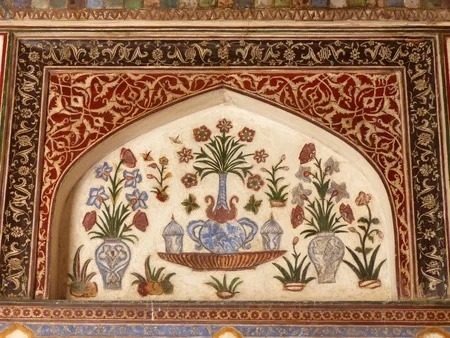
Intérieur Du Mausolée Itimad ud Daulah à Agra, Uttar Pradesh, En Inde
5 notes
·
View notes
Text
Minerets with winding staircases à la mahabat maqbara in junagadh you have bewitched me body and soul and I love I love I love you I never wish to see any architectural structure without you again
0 notes
Text
107 Kombatan Jaringan JI dan JAD Asal Banten Lepas Baiat
SERANG – Sebanyak 107 orang mantan anggota Jemaah Islamiyah (JI) dan Jamaah Ansharut Daulah (JAD) yang ada di Provinsi Banten telah melepaskan Baiat dan berikrar setia kepada Negara Kesatuan Republik Indonesia.
Pengucapan ikrar setia pada NKRI dan lepas baiat yang diselenggarakan oleh Satgas Wilayah Banten Densus 88 Mabes Polri bertempat di lantai 7 Gedung PUPR Banten, pada Rabu…
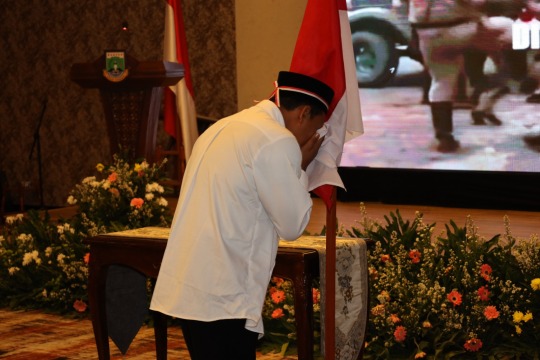
View On WordPress
#Direktur Pencegahan Densus 88 Antiteror Polri Brigjen Pol Ami Prindani#JAD Banten#Jamaah Ansharut Daulah#Kombatan ISIS
0 notes
Text
Agra, India: A Majestic Journey to the Taj Mahal and Beyond
Exploring the Wonders of Agra, India
Agra, the historic city in Uttar Pradesh, India, invites travellers with its rich heritage and the iconic Taj Mahal. This city, known for its architectural marvels and cultural richness, offers a treasure trove of attractions, shopping delights, culinary adventures, and unique experiences that will leave you enchanted. Join us in exploring Agra’s unique charm…

View On WordPress
#Agra#Agra Fort#attractions#culinary adventures#Fatehpur Sikri#India#Itimad-ud-Daulah&039;s Tomb#Jama Masjid#Kinari Bazaar#Mehtab Bagh#Mughal heritage#Mughlai cuisine#River Yamuna Boat Ride#shopping#Sikandra#Taj Mahal#Travel
1 note
·
View note
Note
im curious about tessellations! what makes you like them so much?
hello! i've had this ask sitting here for more than half a year but since i am currently taking a seminar on tessellations i finally feel semi qualified enough to talk about them :D
tessellations are also known as tilings and they're the covering of a plane or surface with the repeating pattern of a specific shape (or multiple shapes) without any gaps or overlaps. like a grid of squares or like in honeycomb which is composed by a bunch of hexagons

there are many types of tessellations and they are usually classified through their types of symmetry. the most basic group of tessellations are called the wallpaper group and they can be simply broken down into regular hexagons (like the ones in the honeycomb), squares, rectangles, equillateral triangles and parallelograms with different types of symmetries depending on things like colors.
for example the four images below (all taken from wikipedia):




regular hexagons, any type of parallelogram (which include squares, rhombi, rectangles, etc), and triangles can always form tilings, which is actually used intuitively in design, like the patterns of fabrics like the dotted pattern below, which can be classified into a symmetry of triangles arranged hexagonally
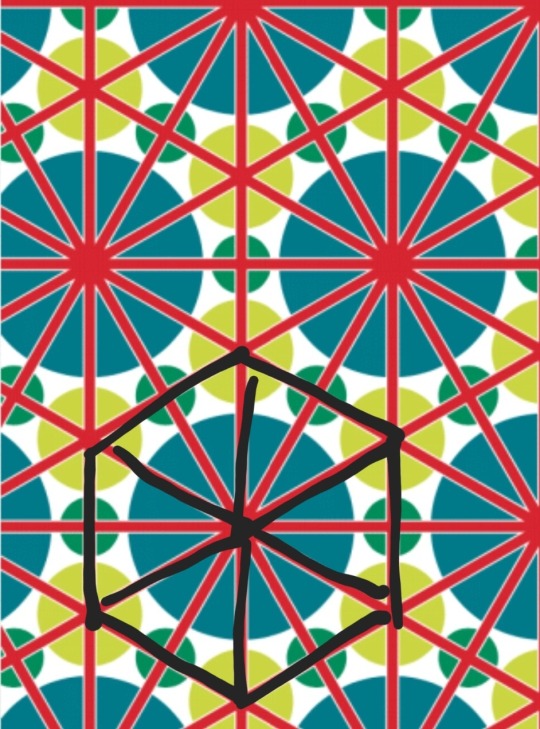
there are infinite types of tessellations that don't belong to the wallpaper group. a specific type that caused a lot of uproar in the math community recently are called aperiodic tilings (you might have seen me talk about this recently bc I was very excited lol)
aperiodic tilings are types of tilings that can't be classified into any type of grid (above you can see triangle grids, square grids etc) in any part of the tessellation. some really popular ones are penrose tilings
the one below is a penrose tiling of two rhombi (again picture taken from wikipedia)
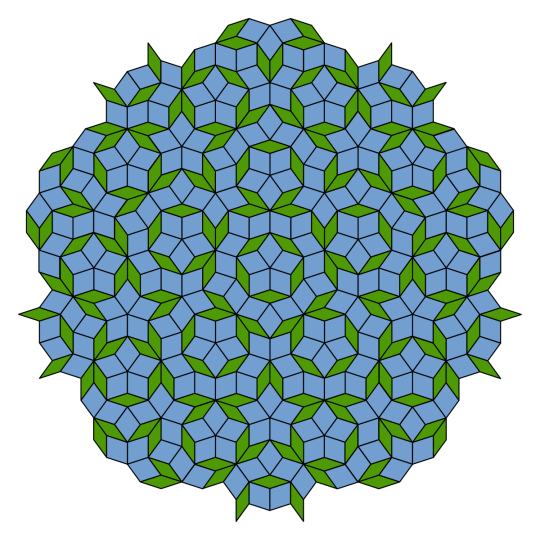
so the interesting thing of the new aperiodic tiling that was discovered (the hat) is that it is a single tile that is aperiodic and no combination of positions of that shape can create a grid, so it is an obligate aperiodic tiling !!! like, the individual pieces of the penrose tiling above could be rearranged into a grid but the hat can't! and it's the first of its kind (the paper hasn't been peer reviewed yet or anything but still very exciting news)

there are a lot of cool examples of tessellations in art like very well known in Islamic art (that is in the tomb of I'timād-ud-Daulah, Agra taken from wikipedia) there's a set of tiles used specifically in islamic geometry called the girih tiles but I don't really know much about them to talk abt them rn

some other well known tessellations are by mc escher (pic taken from this article) and you can see the symmetry behind the patterns
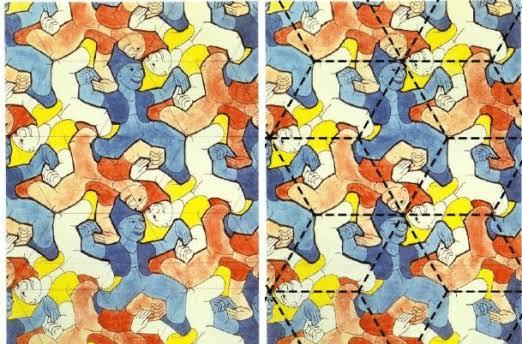
there's so sosos much more about tilings that I could talk about and probably will because I have been absolutely obsessed lately :~D
Here are some links if you're interested in further reading:
Tilings and Patterns, Grünbaum & Shephard (this one is more technical but has a lot of cool examples)
Visions of Symmetry, Schattschneider
The whole wikipedia page of the wallpaper group, has a very technical part but also a lot of visual examples that have helped me understand
The Symmetries of Things, Conway (i dont have a link for this but u can dm me for the pdf)
I also like this video on aperiodic tilings
This is a repository with a bunch of different tilings and it's very fun to look at
#there's a lot more like tilings can also happen in more than 2d but i can't add more pics#but yeah i could go on and on and on about tilings i love shapes and patterns <3#i also hope this makes sense and it's not too badly written or too technical or too casual idk how to write but yeah! tessellations!!#mathposting#mathblr#tilings#tessellations#asks#also sorry if this is too long it could be longer
76 notes
·
View notes
Text
“Perempuan itu kalo enggak disibukkan dengan ilmu, maka dia akan disibukkan dengan perasaan atau hal lain”. -Anonim
Benarlah kata-kata itu, saking sibuknya sama 3.3 sale sampai lupa bahwa tanggal 3 itu runtuhnya daulah islam. Sebuah malapetaka yang menghancurkan umat islam. Ah perempuan memang takbisa jauh dari mengkaji ilmu.
13 notes
·
View notes
Text
“Nothing about the calamitous circumstances of Noor Jahan’s birth ... could have predicted the extraordinary and glorious career she was to have in the most glittering court in the world.
Noor Jahan is born in a caravan, outside the town of Kandahar, as her parents flee poverty and persecution in Tehran to seek their fortune in the rising Mughal court of Akbar in Hindustan. Her parents, Asmat Begum and Mirza Ghiyas Beg, are from a noble Persian family and the child Mehr-un-Nisa is given a thorough education in the Persian arts and letters. The educated, cultured Ghiyas Beg obtains a modest mansab of 300 horse at Akbar’s court at Fatehpur Sikri, which already counts numerous other Persian immigrants in attendance. At seventeen, Mehr-un-Nisa is given in marriage to Ali Quli, a Persian mercenary, who obtains some measure of fame as an excellent shot at the court of Salim Mirza, the future Jahangir, and is given the title Sher Afghan, killer of tigers. Mehr-un-Nisa learns how to hunt and shoot with her husband and gives birth to a daughter, Ladli, in 1605. Three years later, at the age of thirty, Mehr-un-Nisa is widowed. Mehr-un-Nisa and Ladli are taken into the household of the Mughal court, where Jahangir is now padshah. Her father has been awarded the title Itimad-ud-Daulah, ‘Pillar of Government’, and is Jahangir’s revenue minister while her brother, Asaf Khan, is an increasingly influential nobleman of the court. Mehr-un-Nisa is taken into the entourage of Ruqayya Begum, Akbar’s senior-most surviving widow, a childless woman, to whom she is a steady and cherished companion. ‘This Begam,’ writes a Dutch cloth merchant, Van den Broecke, about Ruqayya, ‘conceived a great affection for Mehr-un-Nisa; she loved her more than others and always kept her in her company.’ It is an established custom at the Mughal court that the padshah must protect all the widows and dependent members of those who have served him, and this tradition adds to the ever-growing number of women, children, and retainers in the Mughal zenana. In the imperial zenana, Mehr-un-Nisa has the close companionship of her family, especially her beloved parents, and the enormous network of zenana women.
“...it is in the meena bazaar in 1611 that Jahangir, now a respectable forty-two years old, sees Mehr-un-Nisa with Ruqayya Begum. Jahangir would have known who she was, since Mehr-un-Nisa’s father and brother are already valued members of his entourage, so the circumstances of her family and widowhood are known to him. Speaking to her, Jahangir is now seduced by the beauty, grace and charm of this thirty-four-year-old widow and within two months Jahangir has married her and Mehr-un-Nisa has become Noor Mahal, ‘Light of the Palace’, in a mirroring of Noor-ud-Din, Jahangir’s own title, ‘Light of the Faith’.
Noor Mahal will be Jahangir’s last legal wife and by 1616, she has become Noor Jahan, ‘Light of the World’. They never have any children together and, indeed, by the standards of the day, Noor Jahan is a mature woman, but for the next sixteen years of his life Jahangir will never again search for distraction in a younger wife’s charms. He has always been nurtured and cherished by a coterie of older women—Gulbadan, Haji Begum, Salima Sultan, Hamida Banu and his own milk mother—and in Noor Jahan Jahangir finds a felicitous blend of comforting, reassuring care and a woman with enormous talent, charisma and ability. Noor Jahan shares Jahangir’s aesthetic sense and contributes in many ways to the expansion of his imperial vision and legacy. Within a few years, Noor Jahan is issuing royal farmans signed with her own seal, having gold coins struck in her name, engaging in trade and has a series of magnificent buildings constructed through the breadth of the empire. Exceptionally for a woman, drums are beaten before her advance and ‘sometimes she would sit in the balcony of her palace, while the nobles would present themselves and listen to her dictates’. Noor Jahan’s family, already influential, further prospers as she becomes more powerful. Itimad-ud-Daulah, temporarily disgraced because of charges of embezzlement, which a contemporary writer sarcastically notes when he says that ‘in the taking of bribes he certainly was most uncompromising and fearless’, is reinstated. Asaf Khan, Noor Jahan’s brother, is honoured with the gift of one of Jahangir’s special swords, the Sarandaz, ‘Thrower of Head’, and the atmosphere at the Mughal court becomes conducive to an increasing influx of Persian talent. Where once the Atka Khail and Chagatai reigned supreme, and then the Rajputs, the Persians now are increasingly powerful. But it is in conducting international trade that Noor Jahan is exceptionally successful and the quantum of wealth this creates for her gives Noor Jahan the financial reach to sponsor buildings, offer gifts, organize marriages and entertainments, and sponsor charity, on a scale rarely seen before in a Mughal woman.
“...As for Noor Jahan, her trade with the English is only a small part of her commercial activity. She owns and rents trade ships and trades with the Dutch and the Portuguese, in addition to the English. She collects duties at Sikandarabad on goods coming from Bhutan and Bengal, raw silk, spikenard, borax, verdigris, ginger and fennel, and invests specifically in the commerce of indigo and embroidered cloths. ‘The officers of Noor Jahan Begum, who built their Sarai there,’ clarifies a Dutch merchant, Francisco Pelsaert, ‘collect duties on all these goods before they can be shipped across the river, and also on innumerable kinds of grain, butter, and other provisions, which are produced in the eastern provinces.’ She begins her construction activities as early as 1616, when she spends 200,000 rupees on the Noor Manzil gardens in Agra. She also invests in infrastructure which helps in the smooth functioning of her trade routes. In 1620, following a proclamation from Jahangir for mileage towers, kos minars, to be built along all major highways in a bid to ensure safe travel in the empire, Noor Jahan builds a monumental caravanserai outside Agra called the Serai Noor Mahal. While many caravanserai were built during the reign of Jahangir, the Serai Noor Mahal is particularly magnificent, reflecting the wealth and splendour of its patron. It has large carved gateways, compartments for travellers, a bathhouse and a mosque. Two thousand travellers at a time, along with their camels and horses, can camp inside the serai at no expense. In the serai there are ‘servants, entrusted with the preparation of the food for guests, as well as doing all the other duties essential to comfort within the house, even to providing hot water for washing the feet’. All one has to do, specifies Manucci, is send for food from the nearby bazaar, since all other needs are met. ‘If the guests have horses,’ moreover, the servants ‘are required also to cook mung or chick pea, which is given instead of the barley we feed such animals in Europe.’ All this is done for just a small coin, which Manucci marvels at, admiring the servants’ work ethic when he says that ‘uncivilized and heathens though they are, they surpass our stable men and innkeepers of Europe’ who apparently are much more voracious in their fees. At night, the huge gates to the serai are slammed shut and bolted, to guard against thieves and brigands. The guard shouts out a warning to all the travellers, to guard their belongings, picket their horses by the leg and stay vigilant against wild dogs ‘for the dogs of Hindustan are very cunning and great thieves’. While most of the serais in the Punjab are relatively pedestrian, made from bricks, the Serai Noor Mahal is made from red sandstone, brought at great expense from the quarries at Fatehpur Sikri more than 300 miles away. The serai is decorated with traditional Islamic arabesques, but also with the Tree of Life and the flower pot of Persian iconography and elephants, peacocks and human figures reflecting the influence of Hindu art. There is also an inscription on the serai that proudly announces the name of the patron, the ‘angel-like Noor Jahan Begum’ so that all the traders and travellers on this lucrative trade route between Agra and Lahore are reminded of the power and compassion of the Mughal shahzaadi.
The trade, revenues collected and exorbitant gifts offered to the queen make Noor Jahan an exceedingly wealthy woman. In 1622, upon the death of her father Itimad-ud-Daulah, Jahangir awards the entire estate of this fabulously wealthy man to Noor Jahan, completely bypassing the dead man’s son, Asaf Khan. Noor Jahan is now the wealthiest woman in the Mughal empire and, arguably, in the world. Indeed Pieter van den Broecke, a Dutch cloth merchant, remarks that at the time of Jahangir’s death in 1627, Noor Jahan had amassed wealth ‘more than that left by the King’ himself. Jahangir himself had dazzling amounts of wealth which Hawkins estimated at half a billion rupees, a clearly inflated figure, but nonetheless a reflection of the visible opulence of the Mughal empire.
...Noor Jahan continues to be a dominant player in court politics and is also capable of being a talented and constant companion to Jahangir in all his activities. She is by his side in Ajmer when he participates at the urs at Moinuddin Chishti’s shrine. Jahangir has a large cauldron made in Agra and brought to Ajmer during the saint’s death celebrations. The padshah ‘ordered them to cook food for the poor in that pot, and collect together the poor of Amir to feed them whilst I was there’, Thomas Coryat, an English traveller, is surprised to note. He also observes Jahangir ‘kindling a fire with his own hands and his Normahal under that immense…brasse-pot, and made kitcherie for 5000 poor, taking out the first platter with his own hands and serving one; Normahal the second; and so his ladies all the rest’. Noor Jahan often accompanies him on the hunt, which Jahangir is very fond of, and excels at it. She understands his flamboyant need for entertainment as distraction from his many ills and occasional bad humour and organizes the most resplendent feasts. Even to the details of her involvement in embroidery design, clothing and jewellery, she demonstrates a fine taste which reflects Jahangir’s. Noor Jahan loves the colour white, and favours clothes in paler colours, as opposed to the more riotous tastes of the Rajput and other Hindu wives. She invents the farsh-e-chandani, a spreading of snow-white sheets instead of carpets in a room. She also invents the dodamni, a light cloth weighing two dams, and the pachtoliya, a cloth weighing five tolas, as a head covering for women, the high Turkish hats having long disappeared from the Mughal court. Jahangir too is an aesthete and passionately interested in the clothes and jewellery worn at the court. All his clothes are designed expressly only for him, and he wears them just once. Certain textiles and garments are reserved solely for his use and no courtier may use them. He introduces the fashion of embroidery on the collar and the hems of the long sleeves of the qaba. He also starts the fashion for earrings for men when in 1615, after a recovery which he believes he owes to Moinuddin Chishti, he has pearl earrings made which signified that he was a slave of Moinuddin. All the nobles and courtiers immediately do the same and now it is de rigueur for the elegant men of the Mughal court to wear earrings. Even Asmat Begum, Noor Jahan’s mother, contributes to the elegance of the courtly life by making perfumes. The Mughals love perfumes, having a visceral hate for the sweat that is provoked by the intolerably hot climate of Agra and Delhi. They bathe frequently and change their clothes every day, casting off their day-old clothes, handing them on to their servants. Incense is burned throughout the day through the rooms of the zenana and fresh flowers are brought in from the flower gardens to perfume the rooms. Chameli, mogra, champa, nargis, harsinghar gulab, kamal and malti are some of the flowers grown in the palace gardens and scent is also extracted from these flowers. One day, while Asmat Begum is making rose water, she finds that a scum is formed on the top of this hot concoction and that by collecting the scum bit by bit, she is able to gather a potent oil of such strength ‘that if one drop be rubbed on the palm of the hand it scents a whole assembly and it appears as if many red rosebuds had bloomed at once’. Jahangir is delighted by this perfume, which Salima Sultan tactfully names Itr-e-Jahangiri. ‘It restores hearts that have gone,’ exclaims the jaded padshah, ‘and brings back withered souls’. Noor Jahan and her talented family surround the emperor with beauty and elegance and it is not surprising that according to the eighteenth-century biographer Shah Nawaz Khan ‘the emperor used to say that until she came to his house, he had not understood domestic pleasures or the spirituality of marriage’.
... Noor Jahan is now at the height of her power and influence at the Mughal court. Her family have also become immensely successful, marrying into the Persian nobility and gaining steady promotions under Jahangir, none more so than Itimad-ud-Daulah. As early as 1617, Jahangir honours him ‘as an intimate friend by directing the ladies of the harem not to veil their faces before him’. There are very few men, apart from the padshah, his young sons and the eunuchs, who are allowed to visit the women of the zenana when they are without their veils so this is a high honour indeed. Itimad-ud-Daulah is appointed prime minister and granted a flag and a drum and, as a special favour, is permitted to sound his drums in the royal presence. In 1619, as part of elaborate Navroz celebrations, Itimad-ud-Daulah presents to Jahangir a magnificent throne, made by a Frenchman and erstwhile counterfeiter of precious stones. Augustin Hiriart is hired by Jahangir for his skill in making beautiful, jewelled objects, and at the Mughal court he is renamed Hunarmand from the Persian hunarmandi or skilful. The throne that Hunarmand has created takes three years to build and costs a staggering 450,000 rupees and Jahangir is well pleased. Jahangir is able to delegate most matters to his talented wife while he occupies himself with the matters that interest him the most: the beauty of the natural world, his ateliers with their painters of miniatures and the aggrandizement of the imperial image through the visual arts. Jahangir consults Noor Jahan, Itimad-ud-Daulah or Asaf Khan on most matters and the biographer Shah Nawaz Khan agrees that ‘the disposal of the affairs of the kingdom were in her hands’. Such is her power that ‘except for the khutba not having been read in her name, she exercised all the prerogatives of royalty’. The farmans she issues are wide ranging and numerous, similar in scope to Jahangir’s edicts. Moreover, whereas the earlier Mughal women such as Hamida Banu and Harkha Bai had simply had their names written on their seals, Noor Jahan’s seal on her farmans reads; ‘By the light of the sun of the emperor Jahangir, the bezel of the seal of Noor Jahan the Empress of the age has become resplendent like the moon.’
In 1621, Asmat Begum, Noor Jahan’s mother, dies and Itimad-ud-Daulah is devastated. Within three months of his wife’s death, Itimad-ud-Daulah dies too and for Noor Jahan, this is a shattering loss. She inherits all of her father’s riches and becomes fabulously wealthy but she acquires two powerful new enemies. In the next few years, as Jahangir becomes increasingly ill, his body faltering under the years of assault from wine and opium, various factions across the empire swirl and coalesce together to stake a claim for the Mughal throne. Asaf Khan’s daughter, the young Arjumand Banu has been married for ten years to Khurram Mirza, now Shah Jahan. Disinherited from his own father’s fortunes and wary of his sister’s ambition for her daughter Ladli Begum, Asaf Khan aligns himself with his son-in-law. Noor Jahan, meanwhile, has married Ladli Begum to the youngest of Jahangir’s sons, the handsome but imbecilic Shahriyar. The unfortunate Khusrau is given over to the uncertain care of Shah Jahan, who soon has him murdered, for the Mughal empire has now become worth killing for. The days when Babur encouraged his sons to get along with each other are long gone. There are betrayals and alliances and flickering violence. Noor Jahan enters the fray gallantly, at one point riding on elephant-back to rescue her beleaguered husband, who is practically being held prisoner by his erstwhile faithful retainer, Mahabat Khan, and his army of 5,000 Rajputs, because of the high-stakes intrigues surrounding Jahangir’s sons. But Shah Jahan has gathered a huge following during his years on campaigns for his father and upon Jahangir’s death, in 1627, he becomes Padshah Ghazi of the Mughal empire. Noor Jahan, vanquished, retires to Lahore with Ladli Begum, who is soon widowed when Shahriyar is murdered upon the orders of Shah Jahan. Mother and daughter live in quiet retirement and Shah Jahan decrees a generous yearly allowance of 200,000 rupees for Noor Jahan. All other signs of Noor Jahan’s influence and power, however, are meticulously erased. He bans the use of Noor Jahan’s gold coins, under pain of death, and has all her coins melted. Her royal drums fall silent and the imperial elephants are no longer hers to command. Noor Jahan displays the same grace and dignity in retirement as she did when she was Padshah Begum of Hindustan. She dies eighteen years later, and steps into immortality as the most charismatic and influential of the Mughal queens. But before her death, Noor Jahan creates one last piece of art—the ultimate reflection of her flawless aesthetics and her visionary and unique artistic expression. She builds a tomb, from her own funds, for her parents at Agra called Itimad-ud-Daulah’s tomb, which is so beautiful it will be used as an inspiration for a later, more famous, monument to love.
... Noor Jahan owed her meteoric rise to power to her status as the wife of the padshah. From the time that Jahangir dies, her powerful charisma vanishes, like dew on the misty mornings in her flower gardens at Agra. It is poignant that the most ephemerally beautiful and enduring monument Noor Jahan builds is not to the memory of Jahangir, but to her beloved parents, whose warm abiding presence was the bedrock upon which she built her legacy. Noor Jahan will spend eighteen years in charmless obscurity in Lahore, and it will be a galling reality to a woman who once commanded ships and ambassadors. As Shah Jahan settles into Agra and makes it the imperial capital, Noor Jahan may have taken some comfort from the fact that he was circled by a luminescent series of buildings, the Noormahal Serai, the Noor Afza gardens with their pleasure pavilion and, further away, Itimad-ud-Daulah’s tomb, all built through the wealth and the grace of her patronage.”
- Ira Mukhoty, “Daughters of the Sun: Empresses, Queens and Begums of the Mughal Empire”
22 notes
·
View notes
Text
So, here's one for those racists:
To every ignorant north-Indian, who's ever called Bengalis a race of selfish and backstabbing people, and those who say Bengal only prospered because we were bootlickers of the British, here's a simple fact:
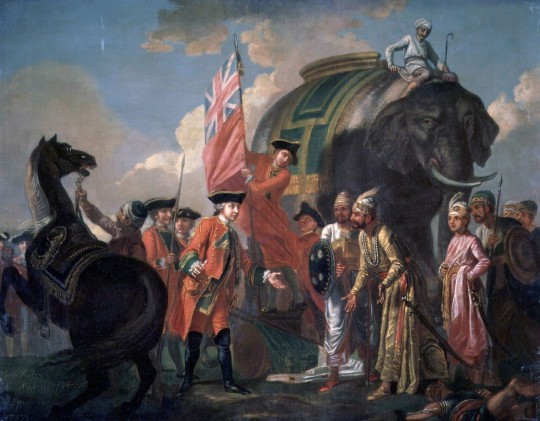
Our erstwhile Nawab of Bengal, Siraj ud-Daulah, defeated the British and kept their influence under control. The Subah of Bengal back then was one of the most influential and wealthy states in the history of South Asia. His general, Mir Jafar (a Delhite btw), who swore to the Nawab by the Holy Quran to fight against the British, betrayed Siraj at the Battle of Plassey for the sake of his own selfish ambitions, thus establishing British rule in the Indian subcontinent. And we all know what the British did to us.
:)
#this just came to my mind#so venting out#i'm sick of these anti bengali comments#bengali#bangla#india#langblr#west bengal#tripura#assam#বাংলা#desi
8 notes
·
View notes
Text
3 HAL PENTING
Saat pandemi dulu, muncul anggapan bahwa organisasi mahasiswa akan turun peminatnya atau bahkan bubar, tak terkecuali KAMMI sebagai lembaga dakwah.
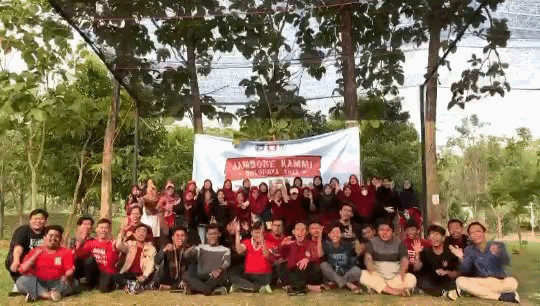
Anggapan itu tak seluruhnya benar, nyatanya masih banyak orang yang mendaftar organisasi mahasiswa. Di KAMMI sendiri, Komsat masih eksis, perekrutan tetap jalan, penjenjangan masih berlanjut, meskipun banyak dinamika di dalamya.
Saya percaya, masih banyak orang di barisan ini, mereka yang ikhlas melangkahkan kaki menuju tempat ini, mengorbankan waktu, harta, dan pikiran, mereka yang akan menyambut generasi-generasi penerus kelak, untuk melangkah bersama menuju keridhoanNya.
Pasca Covid, Gerakan Dakwah dituntut adaptif merespon perubahan, namun sebelum itu, setidaknya ada 3 hal penting yang harus menjadi perhatian bagi setiap kader dakwah agar gerakan dapat muntijah, juga agile menyikapi perubahan:
1. Kader Yang Militan
Ustadz Hilmi Aminuddin Rahimahullah menjelaskan bahwa aset terbesar dakwah bukan lah gedung, uang, dan hal duniawi lainya, melainkan para kader yang membuat gerakan ini bertumbuh dengan segala potensi yang dimiliki, yang akhirnya dapat mengoptimalkan segala kemungkinan-kemungkinan yang ada di dalam organisasi.
Setelah ini, kuatkan lagi ikatan antara kader-kader di komisariat, ingatkanlah kembali apa yang akhirnya membuat kita ada di barisan ini.
Di mulai dengan Realisasi Syahadatain : ketundukan yang mutlak atas perintahnya, niat yang ikhlas, sampai pada amalan yang maksimal.
“Ruh-ruh bagaikan tentara yang tersusun. Jika saling mengenal maka akan bersatu, dan jika saling mengingkari maka akan berpisah.” (Bukhori dan Muslim)
2. Struktur Yang Kuat
Dengan segala potensi yang dimiliki kader, struktur yang efektif dan efisien merupakan kunci untuk menghadapi dinamika zaman.
MK Khos memainkan peran penting di dalam gerakan kita, Bidang Komander perlu menjadi perhatian khusus, di mulai dari proses pengenalan, pembinaan, sampai kepada pengkaryaan, agar tidak muncul kader karbitan, intelektual salon, atau kader yang puber intelektual.
Tentunya peran komander perlu ditopang mekanisme organisasi yang efektif oleh bidang internal, rumah tangga, atau sejenisnya.
Kalau dulu organisasi banyak menerapkan sistem top down/bottom up, cobalah untuk melakukan mengkombinasikan dengan pendekatan kultural kolaboratif yang lebih egaliter antar sturuktur hierarki, semisal PD-Komsat, Ketum-staff, kolaborasi antar bidang, yang intinya membuka sekat agar tidak terkesan ekslusif antar lini.
3. Amal Jamai
Amal Jamai itu dalam makna lebih dalam bukan hanya bergerak secara bersama-sama dalam barisan yang rapi, tapi juga tidak mengedepankan sentimen!
Kejatuhan Turki Usmani menjadi pelajaran besar dakwah kita di tingkat mihwar daulah, bagaimana sentimen antara ras bangsa menjadi jurang pemisah dalam kepentingan dakwah juga umat Islam.
Kepentingan dakwah haruslah menjadi utama di atas kepentingan pribadi atau golongan.
Dalam sebuah dialog dengan seorang Al-Akh, Syaikh Fathi Yakan ditanya :
“Saya tidak memungkiri bahwa saya memiliki ambisi pribadi, dan apakah Islam melarang itu? Setiap Aktivis dakwah pasti memiliki ambisi, bukankah anda juga seperti itu?”
Syaikh menjawab, “Saya tidak memahami Islam seperti itu, tetapi yang saya pahami adalah bahwa Islam mengikis segala ambisi pribadi dan melebur egoisme untuk mencapai tujuan Islam yang tinggi dan mulia. Apabila saya memiliki ambisi, maka ambisi saya adalah ingin melihat bendera Islam tegak dan berkibar.”
“Apa salahnya kalau kita bisa mewujudkan 2 hal sekaligus, ambisi pribadi dan Islam?” Tanya Al-Akh lanjut,
Jawaban Syekh :
Telah diriwayatkan dari Siroh, “Ya Rasulullah, saya menempati suatu posisi untuk mengharap keridhaan Allah, dan aku suka kalau kedudukanku dilihat orang.”
lalu turunlah ayat yang berbunyi :
Katakanlah: Sesungguhnya aku ini manusia biasa seperti kamu, yang diwahyukan kepadaku: "Bahwa sesungguhnya Tuhan kamu itu adalah Tuhan yang Esa". Barangsiapa mengharap perjumpaan dengan Tuhannya, maka hendaklah ia mengerjakan amal yang saleh dan janganlah ia mempersekutukan seorangpun dalam beribadat kepada Tuhannya".
Cita-cita bersama menjadi yang utama, maka di gerakan ini bukan siapa yang menjadi Si Paling Dakwah, Si Paling Intelektual, Si Paling Diskusi, tapi Si Paling Istiqomah.
"Sesungguhnya Allah mencintai orang-orang yang berperang di jalan-Nya dalam barisan yang teratur, mereka seakan-akan seperti suatu bangunan yang tersusun kokoh." (Ash-Shaff : 04)
***
3 hal diatas merupakan penerapan dari Arkanul Baiah yang dimulai dari Al-Fahmu, Al-Ikhlas, Al-Amal, Al-Ukhuwah sampai Tsiqoh.
Untuk mencapai itu dibutuhkan komitmen yang kuat juga kesabaran dalam berjuang. Hari ini kita perlu revitalisasi orientasi kita.
Sungguh, harusnya kita takut dan malu atas amanah yang diberikan meliputi ilmu dan juga kepahaman. Bukankah amanah itu hadir dari Allah dan setiap amanah akan dimintai pertanggungjawaban?
Kita tak akan pernah tahu kapan dipanggil olehNya, tapi semoga apa yang kita lakukan untuk dakwah hari ini menjadi amalan unggulan dan alasan kita untuk berkumpul kembali di Rumah Kita, di JannahNya kelak. Amiin.
(Amanat Apel Jambore KAMMI Solo Raya dengan sedikit penambahan)
16 notes
·
View notes
Photo

Konspirasi yang lahir dari provokasi Yahudi Bani Nadhir dengan berbagai kabilah dari kafir Quraisy memicu persekongkolan jahat untuk memerangi Rasulullah ﷺ dan penduduk daulah Madinah. Inilah salah satu faktor pendorong pecahnya perang Ahzab. Apa yang menyebabkan Yahudi melakukan provokasi dan menghimpune kekuatan untuk menyerang Madinah? Bagaimana Rasulullah ﷺ dan para sahabat menghadapi pasukan koalisi? 🟥 *SAKSIKAN LIVE KHILAFAH CHANNEL REBORN* _Bedah Kitab ad Daulah al Islamiyyah Eps. 27_ *PERANG AHZAB (غزوة الأحزاب)* 🎙️ Bersama : *KH. Yasin Muthohar* Host: *Guslin Al-Fikrah* 🗓️ *Selasa, 10 Januari 2023* 🕗 Pukul : *20.00 WIB* Melalui *Link*: ⤵️ https://youtu.be/MHvlrlRWjpI https://youtu.be/MHvlrlRWjpI https://youtu.be/MHvlrlRWjpI Subscribe channel *KC REBORN* ⤵️ https://mbo.is/official-kc https://mbo.is/official-kc https://mbo.is/official-kc *Jangan biarkan* informasi menarik dan berharga ini hanya berhenti di anda, *yuk sebarkan* ke teman, sanak saudara dimanapun berada. *Biar jadi amal shalih* dan kebaikan menyebar di bumi kita ini. #khilafahchannel #kcreborn #kajiansunnah #kajianislam #kajianonline #sejarah #sahabat #khilafah #khalifah #jihad #perang #ahzab #daulah #Madinah https://www.instagram.com/p/CnOV2vbJg7j/?igshid=NGJjMDIxMWI=
#khilafahchannel#kcreborn#kajiansunnah#kajianislam#kajianonline#sejarah#sahabat#khilafah#khalifah#jihad#perang#ahzab#daulah#madinah
0 notes
Text
my ex best friend (who has "backstabbed" me at least 4 (known) times) played the role of mir jafar for a tiny class presentation. the scene she enacted was that of her stabbing the young nawab siraj ud-daulah in the back.
a few months ago, i was cast as siraj ud-daulah for the annual class drama.
if youre not indian and don't know why this is hilarious & ironic in an almost shakespearean way, the lore is under the cut.
to put it short, siraj ud-daulah was the nawab of bengal for a relatively short period of time. british officials, including robert clive, had partnered w him for trading & business purposes (for the english east india company).
the british had sights on the kingdom of siraj for a while & to overthrow him, conspired with siraj's most trusted general mir jafar.
in the war with the british (forgor the name) siraj would've won if not for mir jafar's betrayal - causing him to seek refuge elsewhere.
my ex best friend metaphorically as well as literally played the role of mir jafar to my siraj ud-daulah.
i love this so much brb just romanticising my abandonment & pain by intertwining my grief with shakespearean elements
11 notes
·
View notes
Text
Golden Triangle Tour 7 Days | Book Delhi Agra Jaipur Tour for 7 Days
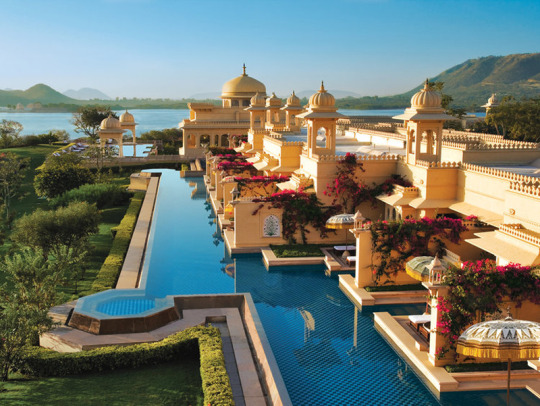
Overview: Golden Triangle Tour 7 Days
The Golden Triangle Tour is a popular itinerary in India that covers Delhi, Agra, and Jaipur. In a 7-day tour, you can explore iconic landmarks such as the Taj Mahal, Qutub Minar, Amber Fort, and experience the rich cultural heritage of each city. The extra day allows for a more relaxed and immersive experience, giving you ample time to soak in the history, architecture, and local flavors of the region.
Certainly! The Golden Triangle Tour is named after the triangular shape formed by the cities of Delhi, Agra, and Jaipur. It is one of the most sought-after tourist routes in India, offering a perfect blend of history, culture, and architectural wonders.
In a 7-day tour, you can start your journey in Delhi, the capital city of India. Delhi is known for its contrasting blend of old and new, with iconic landmarks such as the Red Fort, Jama Masjid, Humayun's Tomb, and the modern marvel of Akshardham Temple. You can explore bustling markets like Chandni Chowk and indulge in the diverse culinary delights the city has to offer.
From Delhi, you will proceed to Agra, home to the magnificent Taj Mahal, one of the Seven Wonders of the World. This white marble mausoleum is a UNESCO World Heritage site and a symbol of love. You can spend ample time exploring the Taj Mahal, as well as other notable attractions like Agra Fort and Itmad-ud-Daulah's Tomb.
Next, you will head to Jaipur, the vibrant capital of Rajasthan. Known as the "Pink City," Jaipur is famous for its stunning forts, palaces, and colorful markets. You can visit the majestic Amber Fort, take a photo stop at the Hawa Mahal (Palace of Winds), explore the City Palace, and immerse yourself in the local culture at the bustling bazaars of Jaipur.
Throughout the tour, you will have the opportunity to witness the rich cultural heritage of India, interact with friendly locals, savor delicious cuisine, and shop for handicrafts, textiles, and jewelry.
A 7-day Golden Triangle Tour allows for a more relaxed pace, giving you ample time to explore each city and soak in the unique experiences they offer. It is a perfect way to experience the essence of India's history, architecture, and vibrant culture.
Contact for Booking
Phone/ Whatsapp - +91 93018 24336
Email - [email protected]
Website- www.indiatripo.com
Website -www.bookgoldentriangletours.com
#holiday#india#london#tourism#travel#united kingdom#destination#places to visit#traveling#vacations#trends#treding#golden triangle tour#coupletravel#couple#travelcommunity#travel photography#explore#travel blog#vacation
2 notes
·
View notes
Text
Explore the Marvels of Agra with Same Day Agra Tour by Premium Car!
Welcome to Agra, the city that boasts the world-famous Taj Mahal! we're dedicated to making your Indian travel experience truly memorable. 🇮🇳

🚗 Your Comfort, Your Choice 🚗 Experience the grandeur of Agra in style as we take you on this remarkable Same Day Agra Tour in a premium car of your choice.
Tour Highlights: 🌅 Pickup from Delhi 🕌 Taj Mahal Sightseeing 🏰 Agra Fort Exploration 🎨 Live Rug and Marble Inlay Making 🌆 Return to Delhi
Itinerary: 🕕 6:00 AM: Begin your adventure with a pickup from Delhi Airport/Railway station. Our driver will be at your service to ensure a smooth start to your journey.
🚗 Transfer to Agra: Enjoy a comfortable ride as we head to the enchanting city of Agra.
🏰 9:00 AM: Arrive in Agra, where the magnificent Taj Mahal awaits you.
🕌 9:15 AM: Witness the unparalleled beauty of the Taj Mahal, a true wonder of the world.
🏰 11:00 AM: Explore the historic Agra Fort, a UNESCO World Heritage Site that has witnessed centuries of history.
🍽️ 1:30 PM: Savor a delicious lunch and recharge for the rest of your adventure.
🏛️ 2:30 PM: Visit Itimad-Ud-Daulah, a beautiful tomb often referred to as the "Baby Taj."
🚗 5:00 PM: Bid farewell to Agra and depart for Delhi, where we'll ensure you're safely back by evening.
2 notes
·
View notes
Photo

Tomb of I’timād-ud-Daulah, Agra, India
Photo by Ibrahim Rifath on Unsplash
Agra, India
Free to use under the Unsplash License
Send me some gas money!
28 notes
·
View notes